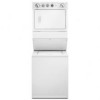Whirlpool WET3300SQ User Instructions - Page 3
Warning
 |
UPC - 883049046570
View all Whirlpool WET3300SQ manuals
Add to My Manuals
Save this manual to your list of manuals |
Page 3 highlights
IMPORTANT SAFETY INSTRUCTIONS WARNING: To reduce the risk of fire, electric shock, or injury to persons when using the washer/dryer, follow basic precautions, including the following: ■ Read all instructions before using the washer/dryer. ■ Do not place items exposed to cooking oils in your dryer. Items contaminated with cooking oils may contribute to a chemical reaction that could cause a load to catch fire. ■ Do not wash or dry articles that have been previously cleaned in, washed in, soaked in, or spotted with gasoline, dry-cleaning solvents, other flammable, or explosive substances as they give off vapors that could ignite or explode. ■ Do not add gasoline, dry-cleaning solvents, or other flammable, or explosive substances to the wash water. These substances give off vapors that could ignite or explode. ■ Do not allow children to play on or in the washer/dryer. Close supervision of children is necessary when the washer/dryer is used near children. ■ Before the washer/dryer is removed from service or discarded, remove the doors to the washer/dryer compartments. ■ Do not reach into the washer/dryer if the tub, agitator or drum is moving. ■ Do not install or store the washer/dryer where it will be exposed to the weather. ■ Do not tamper with controls. ■ Clean dryer lint screen before or after each load. ■ Under certain conditions, hydrogen gas may be produced in a hot water system that has not been used for 2 weeks or more. HYDROGEN GAS IS EXPLOSIVE. If the hot water system has not been used for such a period, before using the washing machine, turn on all hot water faucets and let the water flow from each for several minutes. This will release any accumulated hydrogen gas. As the gas is flammable, do not smoke or use an open flame during this time. ■ Do not repair or replace any part of the washer/dryer or attempt any servicing unless specifically recommended in this Use and Care Guide or in published user-repair instructions that you understand and have the skills to carry out. ■ Do not use fabric softeners or products to eliminate static unless recommended by the manufacturer of the fabric softener or product. ■ Do not use heat to dry articles containing foam rubber or similarly textured rubber-like materials. ■ Keep area around the exhaust opening and adjacent surrounding areas free from the accumulation of lint, dust, and dirt. ■ The interior of the machine and dryer exhaust vent should be cleaned periodically by qualified service personnel. ■ See "Electrical Requirements" section for grounding instructions. SAVE THESE INSTRUCTIONS Checking Your Vent Your dryer must be properly installed and vented to achieve maximum drying efficiency and shorten drying times. Use the minimum recommended installation clearances found in the Installation Instructions. See the Installation Instructions for more information. WARNING NOTE: Service calls caused by improper venting will be paid for by the customer, whether it was a paid installation or selfinstalled. 1. Do not use plastic vent or metal foil vent. Use 4" (10.2 cm) metal or flexible metal vent. Do not kink or crush flexible metal vent. It must be completely extended to allow adequate exhaust air to flow. Check vent after installation. Refer to the Installation Instructions for proper length requirements of vent. Fire Hazard Use a heavy metal vent. Do not use a plastic vent. Do not use a metal foil vent. Failure to follow these instructions can result in death or fire. If the dryer is not properly installed and vented, it will not be covered under the warranty. Proper venting of your dryer is important for satisfactory drying results. See the Installation Instructions for more detail. 4" 10.2 cm 2. Use a 4" (10.2 cm) exhaust hood. 3












